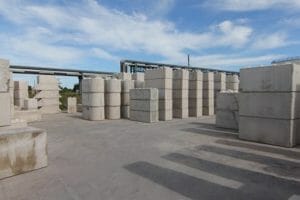Another success in challenging applications
Castle Environmental is a leading supplier of specialist waste treatment, recycling and disposal services, handling in excess of 250,000 tonnes of waste each year. They operate three fully permitted sites in the UK and are proud to be ISO 14001 and ISO 9002 accredited. One type of waste processed at their Cardiff site is APCr (Air Pollution Control residue), the fine powder that remains following the cleaning of gases from Energy from Waste facilities. It contains lime which is alkaline, and consequently APCr is classified as hazardous waste.
For the past 18 months Castle have used recycled APCr as an aggregate replacement in the production of precast concrete products. Following a detailed end of waste review in full consultation with Natural Resources Wales (NRW), APCr is gainfully employed in the manufacture of a range of concrete blocks. The pre-processed APCr is combined with additional aggregates and cement to produce heavy duty interlocking concrete blocks and 4” dense blocks, which are used in construction, civil engineering projects, barriers and bay walls. (See fig 1)
Part of this recycling process involves mixing the APCr powder with recycled water in a 4m high agitated vessel to form a slurry which is then dewatered prior to combining with other aggregates to form the blocks. During this mixing process, the level in the vessel requires careful monitoring and control to ensure the process is carried out under the correct conditions. Inside the vessel there is a very agitated surface, solids can build up on the walls as well as the agitator itself and surface foam can also be produced under certain conditions. (See fig 2)

Figure 2 Challenging conditions – the mixing process produces a very turbulent surface, splashing, surface foam, build up on the walls and vessel internals
The uneven surface, foam and solids build up – are accommodated by the VEGAPULS 64’s 80 GHz radar technology to deliver accurate and reliable level readings. It employs focusing to avoid unwanted interfering signals combined with high sensitivity to read through condensation, sensor build up and to overcome the foaming surface. As well as handling difficult conditions such as these, they are also capable of measuring very low reflectivity hydrocarbons, even liquid gases, highly pure solvents, past complicated vessel internals, down long nozzles and even operating through process isolation valves.




